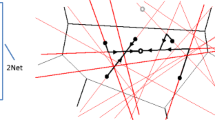Abstract
Optical access networks provide a future proof platform for a wide range of services, and today, several operators are deploying fibre to the home (FTTH) networks. Installing an FTTH infrastructure, however, involves very high investment cost. Therefore, a good estimation of the investment cost is important for building a successful business strategy and, consequently, to speed up the FTTH penetration. In this paper, for calculating the amount of cable and fibre in the outside plant together with the associated civil works, and the number of required network elements, two different approaches are investigated: (1) geometric modelling of the fibre plant based on approximate mathematical models and (2) geographic modelling of the fibre plant based on map-based geospatial data. The results obtained from these two approaches can then be used as input for preliminary investment cost calculations and/or techno-economic evaluations. Compared to more complex and accurate geographic modelling, we verify that especially with uneven population density and irregular street system, simple geometric models do not provide accurate results. However, if no geospatial data is available or a fast calculation is desired for a first estimation, geometric models definitely have their relevance. Based on the case studies presented in this paper, we propose some important guidelines to improve the accuracy of the geometric models by eliminating their main distortion factors.
















Similar content being viewed by others
References
249025-ICT OASE Project. Requirements for European next-generation optical access networks, D2.1.
IEEE 802.3ah task force. http://www.ieee802.org/3/efm.
ITU-T G.984.x series of recommendations. http://www.itu.int/rec/T-REC-G/e.
Ngo, M., Gravey, A., & Bhadauria, D. (2011). Controlling QoS in EPON-based FTTX access networks. Telecommunications Systems, 48(1), 203–217.
Grobe, K., & Elbers, J. P. (2008). PON in adolescence: from TDMA to WDM-PON. IEEE Communications Magazine, 46, 26–34.
Olsen, B. T., Katsianis, D., Varoutas, D., Stordahl, K., Harno, J., Elnegaard, N. K., Welling, I., Loizillon, F., Monath, T., & Cadro, P. (2006). Techno-economic evaluation of the major telecommunication investment options for European players. IEEE Network, 20, 6–15.
Verbrugge, S., Colle, D., Pickavet, M., Demeester, P., Pasqualini, S., Iselt, A., Kirstädter, A., Hülsermann, R., Westphal, F.-J., & Jäger, M. (2006). Methodology and input availability parameters for calculating OpEx and CapEx costs for realistic network scenarios. OSA Journal of Optical Networking, 5, 509–520.
Chen, J., Machuca, C. M., Wosinska, L., & Jäger, M. (2010). Cost vs. reliability performance study of fiber access network architectures. IEEE Communications Magazine, 48, 56–65.
Gardan, D., et al. (1989). Techno-economics of advanced optical subscriber networks. In Proc. IEEE GLOBECOM’89, Dallas, USA, 27–30 November 1989.
Casier, K. (2009). Techno-economic evaluation of a next generation access network deployment in a competitive setting. Ph.D. degree at the Faculty of Engineering of the Ghent University obtained on October 8th.
Casier, K., et al. (2008). Techno-economic evaluations of FTTH roll-out scenarios. In Proc. NOC2008, Krems, Austria, 1–3 July 2008 (pp. 113–120).
Mitcsenkov, A., Paksy, G., & Cinkler, T. (2009). Topology design and capex estimation for passive optical networks. In Proc. BroadNets2009, Madrid, Spain, 14–16 September 2009.
Kantor, M., Wajda, K., Lannoo, B., Casier, K., Verbrugge, S., Pickavet, M., Wosinska, L., Chen, J., & Mitcsenkov, A. (2010). General framework for techno-economic analysis of next generation access networks. In Proc. ICTON 2010, Munich, Germany, 27 June–1 July 2010.
Jarmo, H., et al. (2009). Alternatives for mobile operators in the competitive 3G and beyond business. Telecommunications Systems, 41(2), 77–95.
Mitcsenkov, A., Kantor, M., Casier, K., Lannoo, B., Wajda, K., Chen, J., & Wosinska, L. (2010). Geographic model for cost estimation of FTTH deployment: overcoming inaccuracy in uneven-populated areas. In Proc. IEEE ACP 2010. Shanghai: IEEE.
Olsen, B., et al. (1993). RACE 2087/TITAN: tool for introduction scenarios and techno-economic studies for the access network. In Proc. RACE open workshop on broadband access, Nijmegen, The Netherlands, 7–8 June 1993.
Olsen, B. T. (1997). OPTIMUM methodology. In Proc. OPTIMUM workshop on multimedia techno-economics, Aveiro, Portugal, 20–22 October 1997.
T ONIC project, EU FP5. http://www-nrc.nokia.com/tonic/.
T ERA project, EU FP6-SSP-2005-006469. http://www2.dse.unibo.it/tera/.
Ims, L. A. (Ed.) (1998). Broadband access networks—introduction strategies and techno-economic analysis. New York: Chapman-Hall.
Olsen, B. (1999). OPTIMUM—techno-economic tool. Telektronikk, 2–3, 239–250.
Lannoo, B., Das, G., De Groote, M., Colle, D., Pickavet, M., & Demeester, P. (2010). Techno-economic feasibility study of different WDM/TDM PON architectures. In Proc. of ICTON 2010, Munich, Germany, 27 June–1 July 2010.
Fatma, G., & Erhan, E. (2011). Telecommunications network design with multiple technologies. Telecommunications Systems, 46(2), 149–161.
Mitcsenkov, A., Paksy, G., & Cinkler, T. (2011). Geography and infrastructure aware topology design methodology for broadband access networks (FTTx). Photonic Network Communications, 21(3), 253–266.
AccessPlan framework. http://safranek.tmit.bme.hu/accessplan/.
OpenStreetMap. http://www.openstreetmap.org/.
Acknowledgements
The authors would like to articulate special thanks to Péter Katzenberger (HSNLab) for the population density variance calculations and figures, created for his MSc Thesis, within the frame of the AccessPlan framework.
This work was partly supported by the Network of Excellence “Building the Future Optical Network in Europe” (BONE), funded by the European Commission through the 7th ICT-Framework Programme.
Part of the research presented in this paper was carried out in the frame of the NGAdesigner project, in cooperation with NETvisor Ltd., Hungary, issued by the Hungarian National Development Agency, supported by the EU.
Author information
Authors and Affiliations
Corresponding author
Rights and permissions
About this article
Cite this article
Mitcsenkov, A., Kantor, M., Casier, K. et al. Geometric versus geographic models for the estimation of an FTTH deployment. Telecommun Syst 54, 113–127 (2013). https://doi.org/10.1007/s11235-013-9720-3
Published:
Issue Date:
DOI: https://doi.org/10.1007/s11235-013-9720-3




